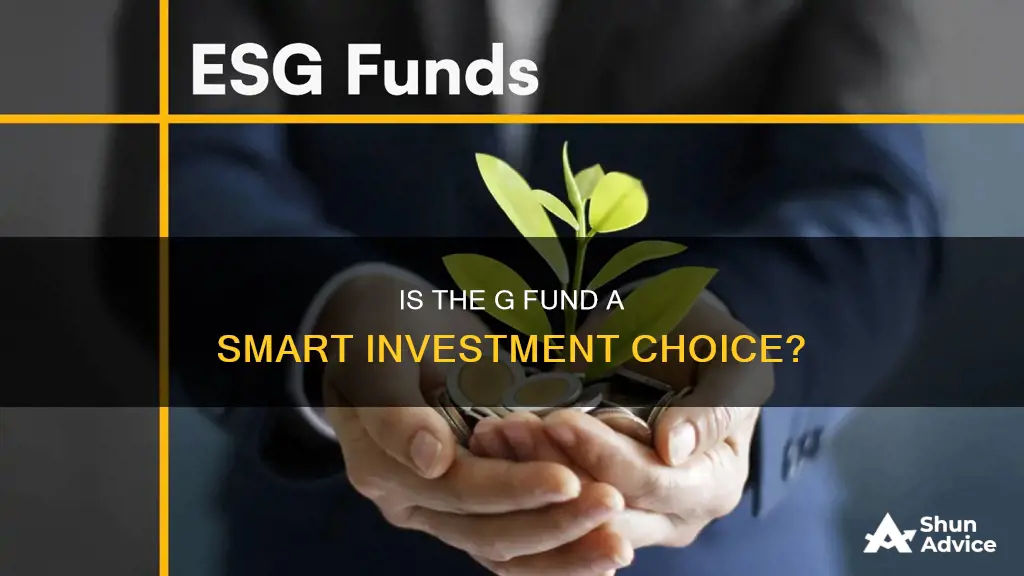
The G Fund is a popular investment option due to its protected account status, which means it can grow but cannot lose money. The fund is backed by the US government, guaranteeing the payment of principal and interest. This makes it a safe choice for investors who want to prioritise stability and preservation of their money. However, the G Fund also comes with the opportunity cost of potentially lower returns compared to other investments. While it aims to provide returns above short-term US Treasury securities, there is a risk that it may not keep up with inflation, leading to a loss of purchasing power over time. Investors considering the G Fund should carefully weigh their risk tolerance, investment goals, and the potential trade-off between stability and higher returns.
| Characteristics | Values |
|---|---|
| Type of account | Protected account |
| Available to | Federal government employees |
| Objective | Preservation of capital and generate returns above those of short-term U.S. Treasury securities |
| Payment | Guaranteed by the U.S. Government |
| Risk | Subject to inflation risk |
| Investment | Invested in U.S. Treasury securities |
| Returns | Medium to long-term interest rates with no risk of losing money |
| Average annual growth | 1.94% over the last 10 years |
| Assets | $294.9 billion as of 12/31/2023 |
| Total expense ratio | $0.490/$1,000 account balance 0.049% (4.9 basis points) |
| Inception date | 4/1/1987 |
What You'll Learn

The G Fund is a protected account
The G Fund is a popular choice because your money is safe from market downturns. These are worry-free investments, but they come with an opportunity cost. The G Fund's annual average growth over the last 10 years was only 1.94%. While your money is protected, you may be missing out on better returns.
The G Fund is subject to the possibility that your investment will not grow enough to offset the reduction in purchasing power that results from inflation (inflation risk). The biggest risk of the G Fund is that an investor will lose purchasing power over time as the interest rate may not keep up with inflation.
The G Fund is invested in short-term US Treasury securities. The interest rate is calculated as the weighted average yield of approximately 183-191 US Treasury securities on the last day of the previous month. The interest rate resets each month and there is zero principal risk.
The G Fund is unique and is only available to those who invest through TSP. It is a great investment vehicle, particularly for those who are very risk-averse.
You Invest: Exploring Mutual Fund Options
You may want to see also

It's guaranteed by the US government
The G Fund is a protected account, meaning it can grow but cannot lose money. The G Fund (the G stands for Government Securities) is the only account in the TSP that is a protected account. It is a popular choice since your money is safe from market downturns. These are worry-free investments, but they still come with an opportunity cost. The G Fund's annual average growth over the last 10 years was only 1.94%. Your money is protected, but you might miss out on better returns.
The G Fund is backed by the full faith and credit of the US government, so there is no "credit risk". The payment of G Fund principal and interest is guaranteed by the US government, meaning the government will always make the required payments. The G Fund buys short-term US Treasury bonds, which pay an interest rate based on the weighted average yield of all outstanding Treasury notes and bonds with 4 or more years until maturity. The interest rate is reset each month, so the bonds have zero principal risk.
The G Fund is a unique investment vehicle only available to those who invest through the TSP. The G Fund is invested in non-marketable US Treasury securities specially issued to the TSP. The G Fund rate is calculated by the US Treasury as the weighted average yield of approximately 191 US Treasury securities on the last day of the previous month. The G Fund's investment objective is to ensure the preservation of capital and generate returns above those of short-term US Treasury securities.
The G Fund has been successful in meeting its objectives throughout its life. It has easily outpaced the growth of the Consumer Price Index. Over the past 34 years, an investment in the G Fund has almost doubled its real value.
Selecting Investment Funds: A Comprehensive Guide
You may want to see also

It's subject to inflation risk
The G Fund is subject to inflation risk. This means that there is a possibility that your investment will not grow enough to offset the reduction in purchasing power that results from inflation. While the G Fund is guaranteed by the US government and has no credit risk, it may not keep up with the rate of inflation, leading to a loss of purchasing power over time. This is because the G Fund's interest rate is not designed to match the rate of inflation but is instead adjusted each month.
Historically, the G Fund has paid higher interest rates than inflation, but this has not been the case during most of the past decade, especially at the current time. The G Fund currently compounds at a rate well below 2%, while some areas, like medical care, have inflation rates approaching 5%. This means that investors in the G Fund are losing purchasing power, as their returns are not sufficient to offset the impact of inflation.
The impact of inflation on the G Fund's returns can be significant. For example, as of July 31, 2023, the G Fund returns were about 2.31%. After inflation impacted the interest rate being paid by Treasury securities, the rate increased to 3.84%. This higher interest rate is then applied to all money invested in the G Fund, so investors receive the benefit of the higher rate on their total investment.
The G Fund's interest rate is calculated as the weighted average yield of approximately 183-191 US Treasury securities on the last day of the previous month. This means that while the G Fund is invested in short-term securities, TSP investors get a higher interest rate, similar to that of longer-term T-notes and T-bonds. However, during times of high inflation, the G Fund's interest rate may not be sufficient to offset the reduction in purchasing power, resulting in an inflation risk for investors.
To mitigate this risk, investors can consider diversifying their portfolios by investing in a blend of both equities and fixed income, or exploring other investment options outside of the G Fund, such as an IRA, which can provide exposure to a wider range of assets, including precious metals, commodities, digital assets, emerging markets, or individual stocks.
A Guide to Investing in Oaktree Funds
You may want to see also

It's a good option for risk-averse investors
The G Fund is a good option for risk-averse investors as it is a protected account that can grow but cannot lose money. The G Fund is the only account in the TSP that is a protected account, and it is guaranteed by the US government. This means that the US government will always make the required payments and there is no credit risk. The G Fund also has zero principal risk as it buys short-term US Treasury bonds that pay an interest rate based on the weighted average yield of all outstanding Treasury notes and bonds with 4 or more years until maturity. The interest rate is adjusted each month, and the G Fund has no risk of losing your money, regardless of how long you keep the investment.
The G Fund is also a good option for risk-averse investors as it offers stability and preservation of money. The G Fund's investment objective is to ensure the preservation of capital and generate returns above those of short-term US Treasury securities. The G Fund has been successful in meeting this objective throughout its life. As of July 31, 2023, the net returns for the G Fund over a multi-year period were 3.84%.
Another reason why the G Fund is a good option for risk-averse investors is that it offers a higher interest rate than other short-term investments. The G Fund rate calculation results in a long-term rate being earned on short-term securities. This is because long-term interest rates are generally higher than short-term rates, so G Fund securities usually earn a higher rate of return than short-term marketable Treasury securities.
Finally, the G Fund can be a good option for risk-averse investors who are nearing retirement or are already retired. The G Fund can be used to hold one to three years' worth of living expenses, which can be used to live on while delaying cashing in other investments that may be performing poorly. The G Fund has no principal risk and tries to provide a return that beats inflation, so investors can hold onto it until the market improves.
Vanguard Mutual Funds: Choosing Wellesley or Wellington
You may want to see also

It's a short-term investment
If you're looking for a short-term investment, you're probably seeking a safe place to keep your cash before you need to access it in the near future. Short-term investments are typically those made for less than three years.
The G Fund is a unique investment vehicle that is only available to those who invest through the Thrift Savings Plan (TSP). The G Fund buys short-term U.S. Treasury Bonds and pays an interest rate based on the weighted average yield of all outstanding Treasury notes and bonds with four or more years to maturity. The interest rate is adjusted each month, and the bonds have zero principal risk.
The G Fund can be a good short-term investment option if you want to prioritise the stability and preservation of your money over the potential for greater long-term growth. Here are some reasons why investing in the G Fund as a short-term investment may be a good idea:
Safety and Stability
The G Fund offers a high level of safety and stability for investors. The payment of principal and interest is guaranteed by the U.S. government, ensuring that required payments are always made. This means there is no "credit risk" associated with investing in the G Fund. Additionally, the G Fund securities earn a long-term interest rate, and the value of these securities does not fluctuate, providing a stable investment option.
Inflation Protection
The G Fund's investment objective is to preserve capital and generate returns above those of short-term U.S. Treasury securities. It aims to maintain a higher return than inflation without exposing the fund to default risk or changes in market prices. Over time, the interest on G Fund securities has outpaced inflation and 90-day T-bills, helping to protect investors' purchasing power.
Liquidity
The G Fund provides daily liquidity, allowing investors to access their money quickly. This feature is particularly advantageous for short-term investments, as it enables investors to withdraw their funds whenever needed.
Competitive Returns
While short-term investments typically offer lower yields compared to long-term investments, the G Fund has delivered competitive returns. It has outpaced the growth of the Consumer Price Index and nearly doubled its real value over a 34-year period.
In summary, the G Fund can be a suitable short-term investment option for those seeking safety, stability, inflation protection, liquidity, and competitive returns. However, it's important to remember that short-term investments like the G Fund may not provide the same potential for high returns as riskier, long-term investments.
Maximizing Your Roth IRA: Alternative Investment Options
You may want to see also
Frequently asked questions
The G Fund is a protected account, which means it can grow but cannot lose money. It is the only account in the Thrift Savings Plan (TSP) that is a protected account. The G Fund buys short-term U.S. Treasury Bonds.
The G Fund is a popular choice since your money is safe from market downturns. The payment of G Fund principal and interest is guaranteed by the U.S. Government, so there is no credit risk. The G Fund also tries to provide a return that beats inflation.
The G Fund's annual average growth over the last 10 years was only 1.94%. While your money is protected, you might miss out on better returns from other investments. The biggest risk of the G Fund is that an investor will lose purchasing power over time as the interest rate may not keep up with inflation.







